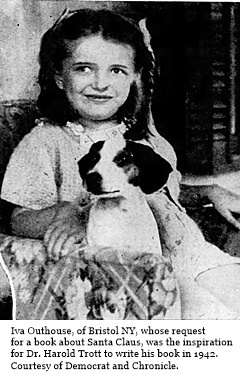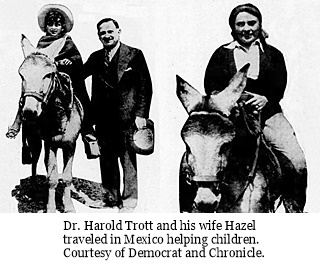
Welcome to Hemlock and Canadice Lakes!
Barns Businesses Cemeteries Churches Clinton & Sullivan Columns Communities Documents Events Time Line Fairs & Festivals Farm & Garden Hiking Homesteads Lake Cottages Lake Scenes Landscapes Library News Articles Old Maps Old Roads & Bridges Organizations People Photo Gallery Podcasts Railroad Reservoir Schools State Forest Veterans Videos
|
Santa Claus in Santa Land by Harold W. Trott |
|
|
The Story behind the Book “Santa Claus in Santa Land” From the Lima Recorder, 25 October 1942. By Ted Snell. Rediscovered by Lore Disalvo.
1 Iva Outhouse of Bristol NY in 1942. “A book all about Santa Claus,” related Dr. H. W. Trott of Hemlock, is the reply he received from Iva Outhouse, a little crippled girl of Bristol, Ontario county, a couple of years ago, when he asked her one day what she wanted for Christmas. Interested in what seemed to him a simple request to comply with, says the doctor, he went confidently to a Rochester book store the next time he was in the city, to buy such a book. To his surprise he not only was unable to find the Santa Claus book he sought, in one store or any store, but upon further research concluded that no such book was on the market. The nearest approach to it was Clement Moore’s “The Night Before Christmas,” written long ago, but still popular among both old and young. So under these circumstances what did the versatile Dr. Trott do? Why, he set out to write a story, himself, “all about Santa Claus” for the little girl. After concluding it in typewritten form, he says, he contacted an old Rochester bookbinder, who quite professionally bound the sheets into what proved to be the first volume of a book that now gives evidence of becoming a best seller. Iva’s simple request brought her the story she sought, but subsequently resulted in a printed edition of 2,000 copies of “Santa Claus in Santa Land.” And now, says the doctor enthusiastically, the second edition is on the press - 100,000 copies in two colors. Here is how the book happened to get into print, as told by Dr. Trott; For some time the original manuscript lay untouched, until one day, Dr. Raymond Trott, an intern in the Buffalo General hospital, the Hemlock doctor’s nephew, read the story when visiting his uncle. Impressed with it, he sent it to a publisher - in fact to three publishers - all of whom accepted the story. Surprised at its reception, Dr. Trott of Hemlock immediately went east to consult a publishing house. Yes, comments Dr. Trott, the publisher contacted would go to the expense of making up suitable art work to fit the story and would also be glad to use the author’s royalties to buy Christmas-stocking presents for crippled children, as the author wished; but when it came to providing, free, a copy for every crippled child on his or her fifth Christmas eve, that was too much; the company ad never followed such a procedure as that and was afraid that too many free copies would be required. About to look up the address of another publishing company, Dr. Trott was given a suggestion by an office employee, to the effect that he might well do his own publishing. The idea took root, with the result, says the doctor, that he undertook the publication of his own book, under writing all of the cost himself. And thus, he says, he can now do as he originally wished - lay aside a fund (four cents royalty per book) to be used each year for the purchase of Christmas stocking presents for crippled children, and also give each crippled child a free copy of the book on his or her fifth Christmas eve. But sale and distribution of the 2,000 copies of that first edition presented a formidable problem as they stood piled up in the doctor’s office. What would he do with them now that he had them? Here is what took place: Copies were sent to a selected list of libraries, and the librarians were asked to review the book and write their appraisals of it. As the replies came back, says Dr. Trott, he was amazed and delighted at the favorable reactions, and - to make a long story short, 8,000 public libraries in the country have ordered around 15,000 copies of this new book. Further a limited list of bookstores had a copy sent for approval, with gratifying results. 2 Dr. Harold W. Trott of Hemlock NY circa 1940. Written comments from librarians are strong in praise of the story - “A child’s story, and a grown-up’s, too,” says one. “It’s a delightful legend that will, for all time, answer the old question “Is there really a Santa Claus?” “It is the most delightful Christmas book I have ever read.” “It fills a great need in juvenile literature.” Etc., etc. From all over the United States have come great quantities of letters, says Dr. Trott, now constituting an enormous file, all so similar in favorable comment that he felt convinced he had “on his line a larger fish than usual,” and the general reception which the book received led him to go ahead with the printing of the large second edition. But three letters of which he thanks the most, first, one from a 91-year-old woman who said it took her back almost a century and once again gave her the delights of Christmas eve as they were then; second, a request from Paul Sperry, director of the national library for the blind, Washington D. C., requesting permission to put the book in braille, so that the story might be made available for the blind of the country (a permission which was granted at once); then there is a third letter, from a small school for the blind in Kentucky, reading, “I do not think this book is worth the ink it took to print it.” Won’t he be surprised, says Dr. Trott, when Washington sends him a braille copy for the school’s library? Dr. Trott’s interest in crippled children is a natural consequence of the fact that at the age of 19 when in medical school he was stricken with a disease known as Landry’s paralysis, from which, as he explains, every muscle in his body, with in twelve hours, was completely paralyzed. As he lay in the Royal Victoria hospital in Montreal, watching the paralysis creep from his legs to his arms, he dragged across his bed from the nearby table the medical student’s “bible,” Osler’s “Practice of Medicine.” And there he read, “One patent was kept alive for forty-one days by artificial respiration (C. L. Green).” Shatting the text book Dr. Trott says he set about trying not only to forget what he had read but to prove that forty-one days was not the limit. Through he ensuing months of complete paralysis, including the diaphragm and eyes, his fellow students, turn by turn, carried on artificial respiration (that was in 1919, before the days of the iron lung) and months later (though not until the skin on the chest wall was rubbed sore, until the rib bones showed) the diaphragm started to react weakly - and what a joy, comments the doctor, to breath all by oneself again though at first for only, a few minutes at a time. Gradually, he continues, the muscles came back, one by one and three years later a much battered, but still confident, medical student turned up at the medical school at McGill university on two crutches, to resume his studies. When asked if any one thing helped pull him through his terrible ordeal, Dr. Trott insists that one thing saved his life. It was this, he explains: His illness came on two months before the final examinations of his first year of the medical course, and when Dr. Charles Martin, then dean of the medical school, heard about the student who would doubtless die within a few hours, he had his secretary type a letter which he himself delivered in person. The letter read: “This is to certify that Harold W. Trott has successfully completed his first year in medicine at this university,” Dr. Trott goes on to say that he was apparently worrying more about losing his year of medical training than about dying, and that when the letter was held up by Dean Martin so he could read it, and later tucked away among the student’s belongings by the same dean, a renewed confidence in recovery was instilled. 3 Dr. Harold W. Trott and his wife Hazel in Mexico. Though somewhat physically handicapped from the illness, Dr. Trott has never let this limit his activities. And he as engaged in many, among them flying his own plane and having his own four-plane hangar at Hemlock before Rochester municipal field had scarcely a start. One of his greatest pleasures is to travel the backroads of Mexico with his wife and 5-year-old son, Edward. But to go back to “Santa Claus in Santa Land,” it looks as if the book has come to stay. It is a story of a man in Holland who, when a child, liked to make toys, and his name, as you may guess, was Christopher St. Nicholas. As he grew older, ... but that would be telling.
|
||
|
Newspaper articles from FultonHistory.com |


